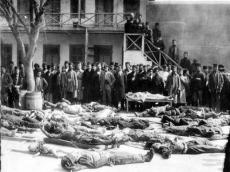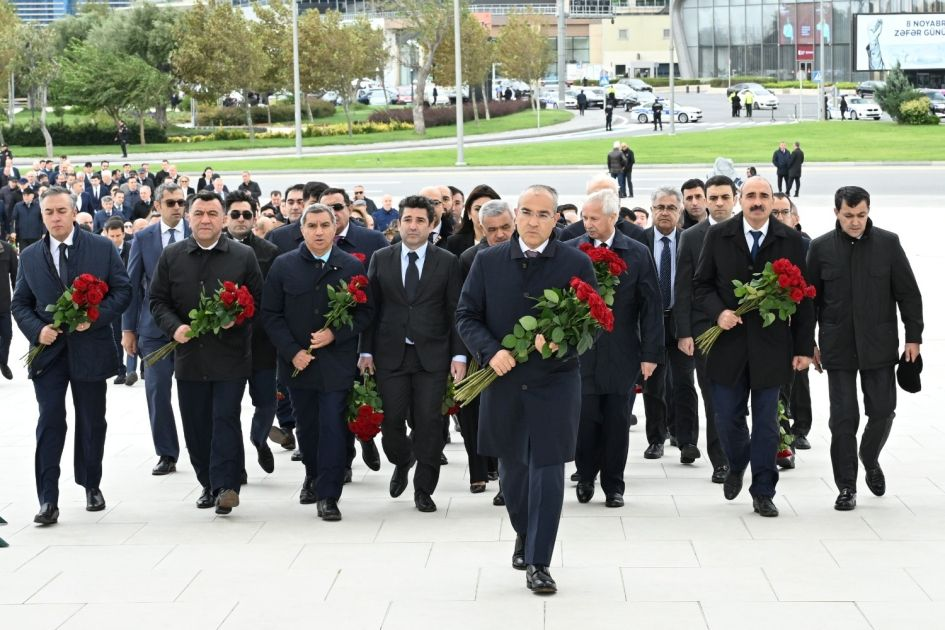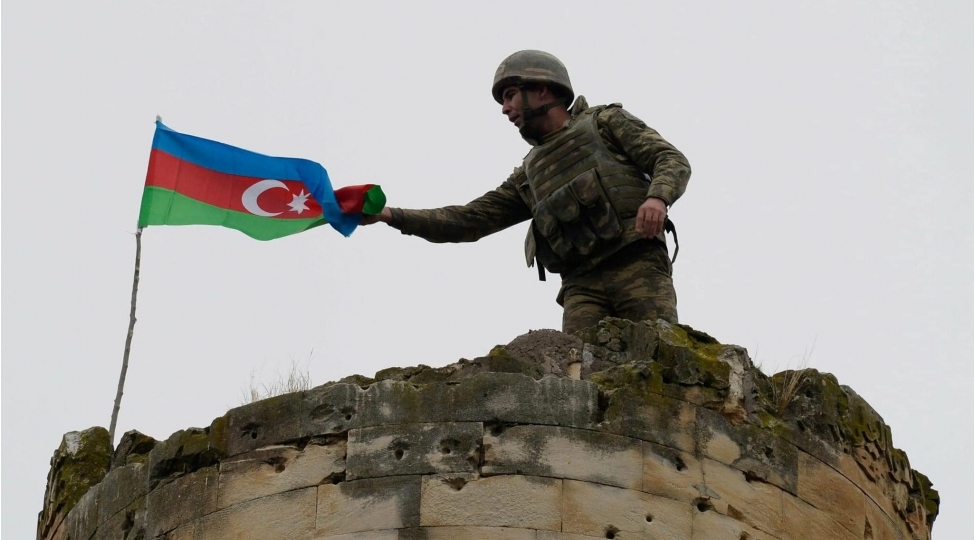|
|
TODAY.AZ / Podcasting
March 31: History suffocated in blood
31 March 2017 [09:47] - TODAY.AZ

By Azernews
By Amina Nazarli
1918 went into history of Azerbaijan as one of the bloodiest pages. Ninety-nine years ago Armenian nationalists with the support of the Bolsheviks committed genocide of Azerbaijanis in Baku and its environs. Bloody events soon spread out covering the entire territory of Azerbaijan.
Bloody streets full of corpses opened a horrifying scene in the capital Baku... Armenians killed Azerbaijanis in every corner of the city just because they were Azerbaijanis.
Professor Ali Hasanov, Assistant of the Azerbaijani President for Public and Political Affairs, Doctor of Science in History in his book gives information about the settlement of Armenians in the territory of Azerbaijan.
Resettlement of the Armenians to Azerbaijani lands
The policy of ethnic cleansing, genocide and aggression deliberately carried out by Armenian nationalists against Azerbaijani people over the past two centuries represents extremely painful and tragic stages in the history of Azerbaijan, including bloody events.
“The main objective of this nationalist and chauvinist policy was to oust the Azerbaijanis from their ancestral lands and to create a fictional state of "Great Armenia" on Azerbaijani territories. Historical facts indicate that the resettlement of numerous Armenians from Iran and Turkey to the mountainous part of Karabakh region of Azerbaijan, which represented tremendous importance in strategic terms, was carried out from the beginning of the 19th century. Over this period, the Imperial Russia, which sought to establish control over the region's vast natural resources, used the "Armenian factor" as a political tool in the war against Turkey and Iran in the late 19th and early 19th century,” the historian writes.
A significant increase in the number of the Armenians in the mountainous part of Karabakh took place in the 1920s, especially after the Russian occupation of the South Caucasus. As a result of mass resettlement of the Armenians in the Russian-Iranian war of 1804-1813 and 1826-1828, the Russian-Turkish war of 1828-1829, and then from Iran, Turkey and South Azerbaijan to the South Caucasus, their numbers here started to increase with every year.
A total of 124,000 Armenians were initially resettled to the mountainous part of Karabakh officially, followed by a large number of those resettled unofficially. Overall, more than 200,000 Armenians were resettled to the mountainous part of Karabakh in 1828-1830s.
Armenian genocide against the Azerbaijanis in the early 20th century
The process of resettlement, which was an integral part of the colonial policy of czarist Russia, continued throughout the 19th century and eventually influenced the demographic situation in the region, according to Hasanov.
The artificial increase of the number of Armenians in the region contributed to the fact that starting from the beginning of the 20th century they began to put forward territorial claims and pursue an aggressive policy against Azerbaijan.
In the early 20th century, Armenian nationalists expanded their activities towards the idea of a "Great Armenia" put forward by the “Dashnaktsutyun” Party, systematically expelled Azerbaijanis from their historical lands and native homes and embarked on a policy of ethnic cleansing and genocide. For example, in 1905-1906 the Armenians committed massacres against Azerbaijani civilians in Baku, Ganja, Karabakh, Erivan, Nakhchivan, Ordubad, Sharur-Daralayaz, Tiflis, Zangezur, Gazakh and other places, perpetrated ruthless massacres against the local population, burned and destroyed cities and villages. Armenian armed forces destroyed more than 200 Azerbaijani villages in Shusha, Zangezur and Jabrayil district, Erivan and Ganja provinces, tens of thousands of our compatriots were expelled from their homes and became refugees and IDPs. After indiscriminately killing more than 200,000 Azerbaijanis (children, women and the elderly), the Armenians carried out ethnic cleansing to create an “Armenian state” on these territories promised to them by czarist Russia. Thus, the Armenians who also enjoyed the patronage of czarism during World War One, continued to inflict punishment on Azerbaijanis.
After the developments that occurred in Russia in February and October of 1917, the “Dashnaktsutyun” Party and the Armenian National Congress launched even wider activities.
In early 1918, i.e. on the eve of the March massacre, the number of Armenian armed forces that reported directly to the Shaumyan constituted nearly 20,000 people. With the support of the Bolsheviks, including Lenin, Shaumyan became the leader of the Baku Commune. On 30 March of that year, Armenian-Bolshevik units subjected Baku to volley fire from ships. Then armed Dashnaks attacked the homes of Azerbaijanis and staged merciless slaughter. On March 31 and in the first days of April, the carnage became even more ruthless. Thousands of Azerbaijani civilians were killed only because of their ethnicity. In those days, Armenian-Bolshevik units destroyed 12,000 Azerbaijani civilians in Baku. During those bloody events people were burned in their homes, killed and tortured with unparalleled cruelty.
As a result of an armed attack by the Armenians, more than 16,000 people were killed with utmost cruelty in Guba province in the first five months of 1918, a total of 167 villages were destroyed, of which 35 do not exist to this day. The facts of mass extermination of the Azerbaijanis of Guba district by Armenian-Dashnak gangs have been recently proven again. Thus, the discovery in 2007 of mass graves in Guba is a fact confirming Armenian vandalism. The study of the burial site has revealed that during an Armenian armed attack on Guba in 1918 people were subjected to unprecedented violence and killed with cruelty. The grave contains remains of mass burials of local residents. It should also be noted that Armenian armed forces under the command of Amazasp also slaughtered the local Jews along with the Turkic-Muslim population. The research has established that in 1918-1919 the Armenians massacred about 3,000 Jews in Guba.
In addition, hundreds of settlements were destroyed and burned in Azerbaijan, including more than 150 villages in Karabakh. A ruthless massacre of the Azerbaijanis was perpetrated in Shusha. In March-April 1918, Armenian Dashnaks tortured and killed about 50,000 people in Baku and other regions of Azerbaijan. More than 10,000 people were ruthlessly slaughtered in Zangezur district, 10,270 in Shamakhi district and 18,270 Azerbaijanis in the city of Shamakhi.
In 1918-1920, of the 575,000 Azerbaijanis living on the territory of the present-day Armenia, 565,000 people were killed and expelled from their native lands. Confirming this figure in a book called "Population of Soviet Armenia in 1831-1931", Z. Korkodyan writes that "in 1920 the Soviet government inherited a little more than 10,000 Turkic (Azerbaijani) population from the Dashnaks. In 1922, after the return of 60,000 Azerbaijanis refugees there were 72,596 people and 105,838 in 1931." In the last two months of 1919, a total of 96 villages were destroyed in Echmiadzin and Surmali districts, all villages in Erivan district and 132,000 Azerbaijanis in Erivan province.
Overall, as a result of the incessant and ruthless massacres unleashed by the Armenians in 1918-1920, tens of thousands of Azerbaijanis were killed and more than a million people were expelled from their native lands in Baku, Guba, Shamakhi, Lankaran, Kurdamir and Shusha, on the territory of Erivan province, Zangezur, Nakhchivan, Sharur, Ordubad, Kars and other regions. When committing these atrocities on historical Azerbaijani lands, the Armenians burned schools and mosques and destroyed samples of material culture.
Territorial claims and military aggression of Armenia against Azerbaijan in the late 20th century
In the late 1980s the Armenians with the help of their patrons in the near and far abroad and using the situation to implement the idea of "Great Armenia", made territorial claims to the Nagorno-Karabakh region of Azerbaijan. Whenever territorial claims to Karabakh were brought forth from the outside under the influence of propaganda, incitement and pressure by the Armenian side, they did not occur immediately, but even before that were prudently prepared by supporters in Yerevan and in the West, also on the basis of a comprehensive plan.
In Soviet times, central authorities have launched a deliberate propaganda campaign against Azerbaijan, which formed a negative public opinion. Armenian ideologists and their inspirers brazenly manipulated information about the history and socio-economic development of Azerbaijan. When the events of 1988 just started, long rallies and demonstrations were organized, the work of enterprises was halted in Khankendi and Yerevan under a deliberate plan to annex the Nagorno-Karabakh to Armenia under the pretext of economic backwardness of the region which was elaborated by Armenian politicians, who were trying to aggravate the situation and mislead the public opinion, and their patrons in the center.
However, subsequent events showed that a false thesis on the socio-economic plight of the Nagorno-Karabakh professed by Armenian politicians and their patrons in the center, was just a pretext, while the main goal was the territorial claims of Armenia against Azerbaijan. Armenian-Azerbaijani ethnic hostilities escalated in the second half of 1980, when the Azerbaijani community of the Nagorno-Karabakh was brutally attacked.
Unfortunately, nobody stopped the Armenian separatists at the beginning, and it just escalated the situation. As a result, receiving both Armenian and Russian material and military support, Armenians committed mass killings of Azerbaijani civilians and these bloody crimes against the Azerbaijanis led to a further widening of the conflict and its expansion into a full-fledged war.
In 1991 the tension in the mountainous part of Karabakh started to gradually worsen. Socio-political situation has already foreshadowed the approach of a major disaster.
In general, from 1988 to 1991, that is, from the beginning of the events until the collapse of the Soviet Union, patronized by the ruling circles of the USSR, Armenia pursued an aggressive policy against Azerbaijan. As a result of this policy, the Azerbaijani civilians were killed, their villages were destroyed, burned and looted. Aggressive state artificially instilled Armenians living in Nagorno-Karabakh region the idea of separation from Azerbaijan and unification with Armenia. To achieve this goal the Armenians subjected to genocide 50,000 Azerbaijanis of Nagorno-Karabakh and forced them to leave their homeland. During these years, Armenians committed 2,559 clashes, 315 armed attacks and 1,388 fires, killing 514 and injuring 1,318 people in the Nagorno-Karabakh.
At the same time during this period as a result of ethnic cleansing an estimated 250,000 civilians living in 185 Azerbaijani villages in Armenia were subjected to aggression and were forced to leave their homes. It was an action of ethnic cleansing, 216 Azerbaijanis were savagely killed, thousands of women, children and old people were injured and property was looted.
In the beginning of 1992, the Armenian army occupied the last Azerbaijani villages in the Nagorno-Karabakh.
Currently, more than 20 percent of Azerbaijani territory is under occupation of the Armenian armed forces.
The aggressive policy of the Armenian armed forces was accompanied by mass slaughters. Thus, in the years 1988-1993 as a result of a military aggression of Armenia more than 20,000 Azerbaijanis were killed, over 100,000 people were injured and 50,000 people became disabled. During the conflict 4,853 people went missing, 1,357 of them were released and 783 are still in captivity in Armenia. According to the International Committee of the Red Cross, 439 people were killed in captivity.
Genocide committed by Armenians in the late 20th century in Khojaly, is regarded as one of the most serious crimes against humanity and civilization. In the history of humanity, the Khojaly tragedy is comparable to tragedies in Khatyn, Hiroshima, Nagasaki, My Lai, Rwanda, Srebrenica, as well as the Holocaust, which will never be erased from historical memory. These massacres are considered the acts of genocide against the civilian population and caused a wide resonance in the world.
Azerbaijan's Ombudsman Elmira Suleymanova said that the genocide committed on March 31, 1918, has not received duly legal assessment on the international arena.
“The purpose of the genocide policy, ethnic cleansing and deportation purposefully carried out by Armenian nationalists and their patrons against Azerbaijanis for more than two centuries, is to drive Azerbaijanis from their historical lands so that to create "Great Armenia” in these territories," she said.
URL: http://www.today.az/news/podcasting/159833.html
 Print version
Print version
Connect with us. Get latest news and updates.
See Also
- 10 March 2025 [15:42]
Azerbaijani MPs reject Swedish-Armenian group's statement, call for justice - 27 January 2025 [08:30]
Azerbaijan’s evolving role in global energy: Oil, gas, and renewable energy collaborations - 02 December 2024 [11:23]
President Ilham Aliyev sends congratulatory letter to President of UAE - 05 October 2024 [13:30]
Azerbaijani deputies to observe referendum in Kazakhstan - 13 September 2024 [15:18]
Artillery units of Combined Arms Army conduct exemplary live-fire tactical exercise - 13 July 2024 [16:34]
Azerbaijan MFA congratulates Montenegro - 29 June 2024 [10:00]
Azerbaijan invited to NATO foreign ministers` summit in Washington - 28 June 2024 [11:55]
UN Secretary-General Antonio Guterres confirms attendance at COP29 in Baku - 16 June 2024 [09:00]
Baku to host 10th Azerbaijan International Insurance Forum - 15 June 2024 [11:41]
President Ilham Aliyev: Cooperation among political parties of countries of OTS plays important role in realization of common goals
Most Popular
 Erdogan’s US visit seen as potential turning point in Ankara–Washington ties [OPINION]
Erdogan’s US visit seen as potential turning point in Ankara–Washington ties [OPINION]
 Ministry of Economy staff honor martyrs at Victory Park on Memorial Day
Ministry of Economy staff honor martyrs at Victory Park on Memorial Day
 Syrian court issues arrest warrant for former president Bashar al-Assad
Syrian court issues arrest warrant for former president Bashar al-Assad
 Chilean senate delegation visits Shusha and Khankendi on Remembrance Day
Chilean senate delegation visits Shusha and Khankendi on Remembrance Day
 Nikol Pashinyan highlights importance of regional cooperation for Peace in South Caucasus
Nikol Pashinyan highlights importance of regional cooperation for Peace in South Caucasus
 Patriotic war, national dignity, eternal remembrance [OPINION]
Patriotic war, national dignity, eternal remembrance [OPINION]
 Armenian PM: I am happy to report to international community that peace established between Armenia and Azerbaijan
Armenian PM: I am happy to report to international community that peace established between Armenia and Azerbaijan
